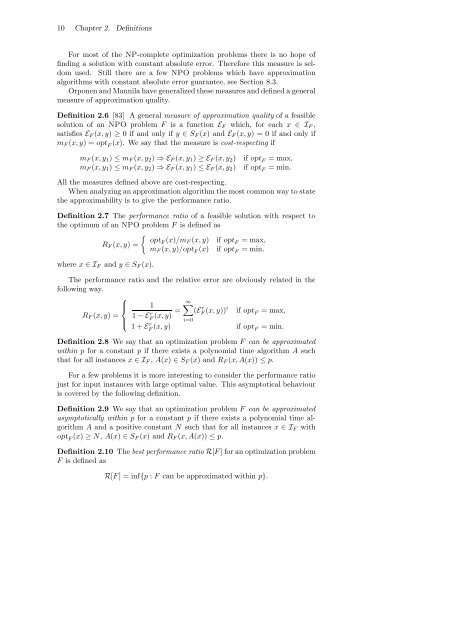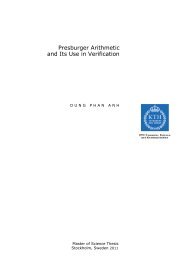On the Approximability of NP-complete Optimization Problems
On the Approximability of NP-complete Optimization Problems
On the Approximability of NP-complete Optimization Problems
You also want an ePaper? Increase the reach of your titles
YUMPU automatically turns print PDFs into web optimized ePapers that Google loves.
10 Chapter 2. Definitions<br />
For most <strong>of</strong> <strong>the</strong> <strong>NP</strong>-<strong>complete</strong> optimization problems <strong>the</strong>re is no hope <strong>of</strong><br />
finding a solution with constant absolute error. Therefore this measure is seldom<br />
used. Still <strong>the</strong>re are a few <strong>NP</strong>O problems which have approximation<br />
algorithms with constant absolute error guarantee, see Section 8.3.<br />
Orponen and Mannila have generalized <strong>the</strong>se measures and defined a general<br />
measure <strong>of</strong> approximation quality.<br />
Definition 2.6 [83] A general measure <strong>of</strong> approximation quality <strong>of</strong> a feasible<br />
solution <strong>of</strong> an <strong>NP</strong>O problem F is a function EF which, for each x ∈ IF ,<br />
satisfies EF (x, y) ≥ 0 if and only if y ∈ SF (x) andEF (x, y) = 0 if and only if<br />
mF (x, y) =opt F (x). We say that <strong>the</strong> measure is cost-respecting if<br />
mF (x, y1) ≤ mF (x, y2) ⇒EF (x, y1) ≥EF (x, y2) if opt F =max,<br />
mF (x, y1) ≤ mF (x, y2) ⇒EF (x, y1) ≤EF (x, y2) if opt F =min.<br />
All <strong>the</strong> measures defined above are cost-respecting.<br />
When analyzing an approximation algorithm <strong>the</strong> most common way to state<br />
<strong>the</strong> approximability is to give <strong>the</strong> performance ratio.<br />
Definition 2.7 The performance ratio <strong>of</strong> a feasible solution with respect to<br />
<strong>the</strong> optimum <strong>of</strong> an <strong>NP</strong>O problem F is defined as<br />
<br />
optF (x)/mF (x, y) if optF =max,<br />
RF (x, y) =<br />
mF (x, y)/optF (x) if optF =min.<br />
where x ∈IF and y ∈ SF (x).<br />
The performance ratio and <strong>the</strong> relative error are obviously related in <strong>the</strong><br />
following way.<br />
⎧<br />
⎪⎨ 1<br />
RF (x, y) = 1 −E<br />
⎪⎩<br />
r ∞<br />
= (E<br />
F (x, y)<br />
i=0<br />
r F (x, y)) i<br />
if optF =max,<br />
1+Er F (x, y) if optF =min.<br />
Definition 2.8 We say that an optimization problem F can be approximated<br />
within p for a constant p if <strong>the</strong>re exists a polynomial time algorithm A such<br />
that for all instances x ∈IF , A(x) ∈ SF (x) andRF (x, A(x)) ≤ p.<br />
For a few problems it is more interesting to consider <strong>the</strong> performance ratio<br />
just for input instances with large optimal value. This asymptotical behaviour<br />
is covered by <strong>the</strong> following definition.<br />
Definition 2.9 We say that an optimization problem F can be approximated<br />
asymptotically within p for a constant p if <strong>the</strong>re exists a polynomial time algorithm<br />
A and a positive constant N such that for all instances x ∈IF with<br />
opt F (x) ≥ N, A(x) ∈ SF (x) andRF (x, A(x)) ≤ p.<br />
Definition 2.10 The best performance ratio R[F ] for an optimization problem<br />
F is defined as<br />
R[F ]=inf{p : F can be approximated within p}.

















